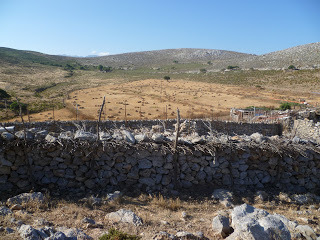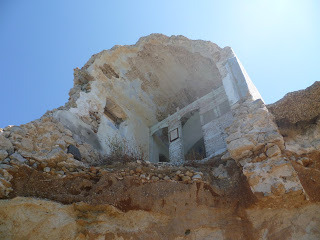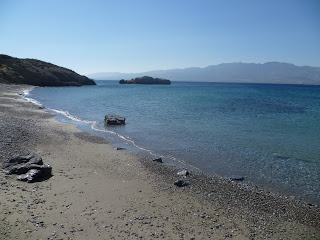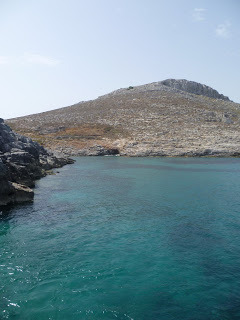Three Days in Pserimos: A Different Experience

Pserimos, one of the smallest inhabited islands in Greece, has an absolutely perfect white-sand beach shelving gradually into a shallow, sparkling blue bay.
Unfortunately, surrounded by Kos, Kalymnos and the shores of Turkey, it’s inevitably become a stop on the day cruise itinerary. An hour after I arrived, the tour boats had come in and the tiny harbour was crowded with pinkish daytrippers wading into the sea or strewn across the cafes. Old folks beckoned me over to buy packets of herbs, and waterside stalls shimmered with things made out of shells. If I’d arrived on one of those boats and seen the island for only that hour, I wouldn’t have fallen in love with Pserimos.
I’d arrived on the regular ferry, however, as a guest of Georgos Karaiskos, who’d taken me under his wing and invited me to pitch my tent under the tall pine trees of the scout camp he runs. I'd found his email address while hunting for information on getting to the island. We’d exchanged a few emails and I explained I lived on another Dodecanese island, Tilos. He’d replied:
‘Nice place, BUT wait until you see and stay for some days at Pserimos. Different experience!!... You will like it, and come every year.’
I hoped he was right; for now I needed a quiet swim, and followed signs to Vathi past a huge olive grove. Reaching the top of the hill, I was crestfallen to see the villa developments of Bodrum in Turkey across the water, a couple of fish farms closer to shore, and the beach full of debris washed in by the sea. A naked couple were clearly enjoying themselves, though, unperturbed by the wasps buzzing around a water-hole for goats. In spite of a rather unusual invitation to join them, I had a quick swim and left them to it.

I still felt Georgos’s claim was a bit of a stretch, but as I followed another path to Marathonta to see some more of the island, it grew on me. The gentle hills, the goats with huge twisted horns and clinking bells, gorse with yellow flowers, sage and thyme bushes; farm enclosures with dry stone walls reinforced with wood and recycled furniture (to keep the goats out); a farmer snoozing with his dog in the shade of a tree; gardens of fig trees and prickly pear, grape vines and flowers.
I decided to stay for a few days and get to know the place a little. And I’m so glad I did.
I got back to the village, strolled to the harbour, and now I had that soft white sand and clear, cool, blue water all to myself.
Georgos had recommended I eat at Sevasti Pikou’s taverna next to the church for good food and good prices – and it also drew in a local crowd – so that’s where I headed, tempting as it was to linger with my feet in the sand. The ‘fylla’, or vine leaves stuffed with rice, meat and tomato, were probably the best I’ve ever eaten, and there was home-made garlicky tzatziki and delicious slices of a huge fish called rinacaught that day – the fisherman showed us the photo on his phone – sprinkled with the local herb throumbi and served with fried potatoes. Georgos joined me for a while and told me about his plans to build cabins at the scout camp for people to come and stay.

The smell of the pine trees around my tent was magnificent. I slept well, woke up with the roaming chickens and the crows. At eight a.m., the whole beach to myself again, I swam across the empty bay, then had coffee and yoghurt and honey on the beach at Themis’ cafe, watching the fishing boats coming in with octopus and sponges and fish. Pserimos at its best seemed hard to beat.
A couple of older ladies bobbed about in the water in their dresses and headscarves. Local men occasionally zipped about on little scooters, one with a goat in the trailer. There aren’t really any roads on Pserimos, just a few sandy paths and dirt tracks, but someone drives an army truck with a ram’s skull and horns on the fender.

Some thirty years ago, the population of the island was over three hundred; now only twenty or so live on Pserimos all year round, mostly old folks. But as summer starts and school finishes, it’s a wonderful place for kids and young people to come back to. The whole island is only a few kilometres long by a few kilometres wide, and great for walking.
To avoid the morning tour boats, I set out to walk to Grafiotissa beach, filling my bottle with water. The island has fresh water and it tastes delicious; from the beach I’d seen a young man drawing water from a well for his grandmother. The path was a little tricky to find at first, past goat pens, but then I was striding across hillsides full of purple-flowering thyme, with deep blue seas below. And within half an hour I got a glimpse of a spectacular sight. A long strip of white sand, rust-red cliffs, and half a small whitewashed chapel perched on top, the other half having fallen into the sea many years ago.


I passed happy hours alone at Grafiotissa. The view from the sand was of the quieter ends of Kos and Kalymnos, the deserted islet of Plati, and the occasional yacht floating by in the distance. In the courtyard of the newer church nearby were fragments of ancient carved stones, and five sheepskins hung to dry on a fence.
On the third day, after a breakfast of fresh bread with local thyme honey, I walked to Krevatia beach. ‘Tha berdepseis poli,’ said an older man in Manola’s café (where the day before I'd feasted on squid grilled on the barbecue), when I asked about which path to take: ‘You’ll get very confused.’ He was right, but I wasn’t in a rush and this walk was perhaps the most beautiful yet. There was another lonely church surrounded by grazing goats, trees blown horizontal by the winds, baled hay. A green swathe of hillside dropped gradually down to a nice stretch of sand and pebbles, again deserted with clear, tranquil sea.


Later, eating roasted aubergines and courgettes, I thought of the things I now knew and loved about Pserimos, having spent a few days here. The birds nesting in the bell-tower of the church next to Sevasti’s taverna, and the food from Sevasti’s kitchen. The communal grove of eight thousand olive trees and the sound of the wind blowing through it; the smell of sage and thyme; the evening noises of the birds, and the bells of sheep and goats grazing. The people who stayed for only an hour or two missed so much. It was hard to wrench myself away in the end, and I swam as many times as I could across the sparkling, clear bay, taking in the pretty houses and hillsides.

The irony was that to get back to Tilos I had to connect to a boat in Kos, which meant leaving on one of the tour boats. But in the end, the crew dancing cheesily to Zorba on deck with a few game passengers was pretty good fun, I had to admit. Maybe they weren’t so bad after all.
Getting there
The Maniai boat (I’m intrigued that Pserimos has a boat named after the ancient demons of mad frenzy) leaves from opposite the Olympic Hotel in Kalymnos harbour at 9.30 a.m. and returns at 5 p.m. (daily from May to October; three times a week out of season). Tour boats leave Kos harbour around 9.30 a.m. in summer, stopping at different times in Pserimos, and leave by around 3.30 p.m.
Where to stay
Pikou Sevasti has rooms above the taverna (pserimos@gmail.com, (0030) 22430 29337), as do most of the cafes, and there’s Kalliston Studios at the corner of the beach (petkoukouva@yahoo.gr, (0030) 698 0389 276). Pikou Sevasti also sells ice and bread, and free showers are available to customers arriving by private yacht.

Published on June 13, 2013 12:08
No comments have been added yet.



